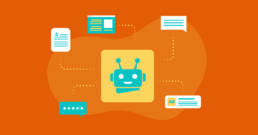
Can ChatGPT Help You Generate Content?

January 19, 2023
share this post
If your organization or association creates content, like we do at Astriata, then chances are, in response to the new developments in artificial intelligence (AI), the following sentiment has crossed your mind:
Maybe we no longer need human content creators.
Yes, that includes the cadre of writers, designers, animators, videographers, and so on who spend countless hours strategizing, planning, researching, and generating visual, written, and audio content—all with the limited capacity of the human brain and the time crunch of the modern work world.
With various forms of generative AI now open and available to us all, most content creators (ourselves included) have pondered the possibility of whether we’re becoming obsolete. Will chatbots and image generators replace us? Will we need to find a new line of work—go back to school, take a series of massive open online courses, and rely on machines to come up with the clever content we work so hard to create?
Although we consider ongoing learning integral to our line of work, we feel confident, at this juncture, that tools like ChatGPT and DALL-E 2 will not replace our abilities to do what we do to connect our clients’ users with ideas and information. But we do think these new tools have the potential to improve how we work and open doors to new processes that will someday become integral—and ordinary—parts of our jobs.
AI as a collaborator
We think the new AI can and will help you do what you, too. But it’s important to think of these developments not as replacements of human involvement but as tools to assist what humans do. The international professional services firm Deloitte created a great term for this relationship with AI, referring to the current era as The Age of With™.
What does Deloitte mean by The Age of With™?
Typically, we think of machines and humans as a dichotomy, meaning that it’s machines versus people. “But the true role of analytics and AI, along with other tools, is collaborative,” Deloitte explains. “The future of artificial intelligence is a future of human potential: people with machines, doing more than either could do alone.”
The Age of With™, then, is an era in which we utilize the power of technology to do our jobs better and more efficiently. How can that start happening? With one of the new AI programs introduced in December, ChatGPT, we see great potential, especially in the realm of writing. This includes everything from blog posts, social media, e-books, and email campaigns to event materials, proposals, grants, and development-related writing. The sky’s the limit on how and where ChatGPT can help.
Utilizing the potential of ChatGPT
If you’ve had a chance to play around with ChatGPT, you know that the main interface features a field in which users can enter a question or a command that the bot then works to fulfill. For example, imagine you’re a nonprofit in the healthcare industry, writing a white paper about how to enhance the patient experience with virtual visits. You might instruct the chatbot to Explain the challenges patients face with virtual doctor visits. Alternatively, you could tweak the language slightly and pose the question this way: What challenges do patients face with telemedicine?
The bot will then generate a fairly comprehensive list of challenges, written and explained in original terms. But if you find that the bot does a sub-par job, or you want to build on or drill down on what you’ve learned, then you can continue to tweak your commands and questions. For example, you can try one (or all) of these:
“What is the biggest disadvantage of virtual healthcare visits?”
“What demographic of patients struggle most with telemedicine, and why?”
“What demographic of patients use telehealth the most, and why?”
Then, if you want to hone in on a certain topic or find something more specific, you might try some of these:
“What percent of patients use virtual healthcare appointments, according to medical research?”
“Find statistics on telemedicine in the United States.”
“What percent of doctors [or healthcare systems] offer telemedicine in the mid-Atlantic?”
Keep in mind, as you play around with ChatGPT, that the bot is designed to be conversational, which means you can ask follow-up questions. Say, for instance, that the chatbot, in response to a query, mentions that telemedicine isn’t always appropriate for patients. You could follow-up on this in various ways, such as:
“Can you describe some scenarios in which telemedicine is not suitable for the patient?”
“Explain five scenarios in which telemedicine is inappropriate.”
“What conditions require in-person doctor visits and treatment?”
When we asked the bot this last question about specific conditions, it provided an impressive answer with a fleshed out list of scenarios that require in-person treatment. It also provided a thorough response to this command, which, essentially, tests the bot’s ability to take on the entire task:
“Write a 2,000-word white paper on how to enhance telemedicine in the healthcare industry.”
The white paper generated by the bot wasn’t great, but it also wasn’t bad. At the very least, it offered ideas on how to structure the white paper and what main topics to consider researching and covering.
And this is where the lines of how to use AI ethically and effectively—a matter we will explore soon—can get tricky. It’s also why school districts, such as New York City Schools, have already banned ChatGPT from their networks and devices, in a move that has generated a great deal of controversy. Some consider the chatbot a gateway to cheating on everything from term papers to algebra, while others say the chatbot technology has arrived, and we need to teach kids how to learn with it, instead of pretending it doesn’t exist.
When it comes to the professional world, our team at Astriata wants to embrace and find ways to work with change, not against it. So we are all for exploring how we can use ChatGPT and other new AI tools to enhance our work processes. That said, we also want to go in with our eyes open by realizing, for example, that ChatGPT doesn’t reveal its sources. So, unless you know a tremendous amount about your topic, you will need to track down sources and vet much of the information yourself.
You will also need to personalize and refine content generated by a chatbot, which we find lacking in language that speaks directly to clients’ needs. After all, the bot doesn’t understand the unique relationships you’ve formed with your clients, members, students, or patients. Only you do.
So, as you start exploring what you can do with ChatGPT, we hope you find these tips and ideas helpful. We also hope, as the new year gets underway, that you continue the important, ongoing work of making your website and other digital assets user-friendly. To find out where you stand on the path to UX maturity, take our fun, fast assessment to determine your UX score now.